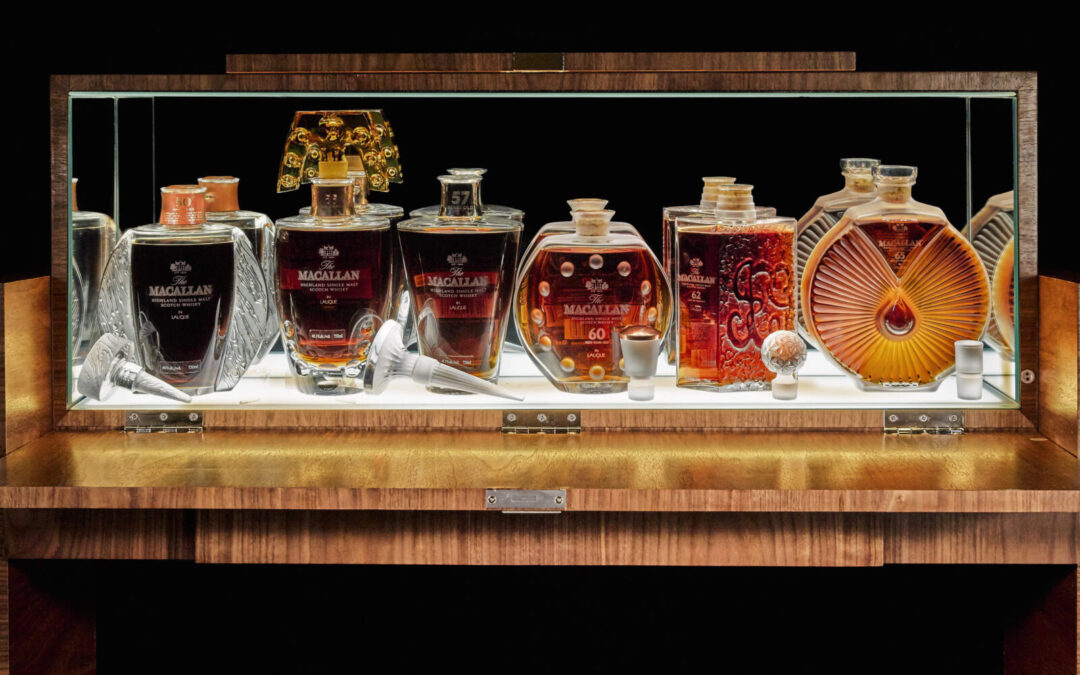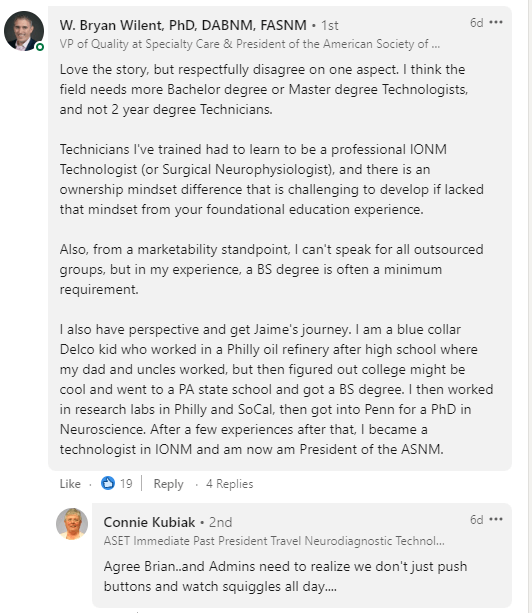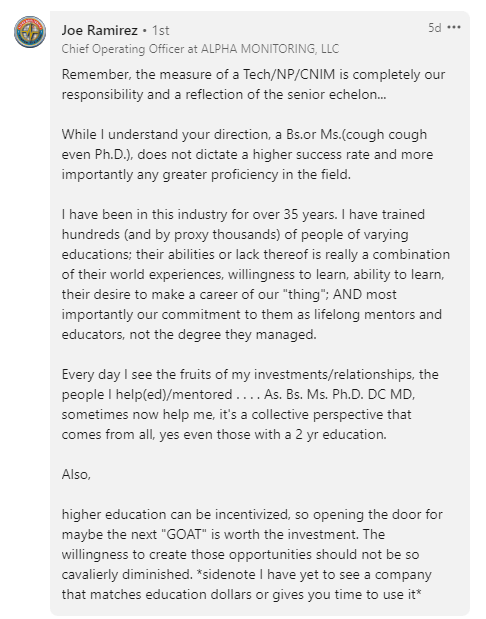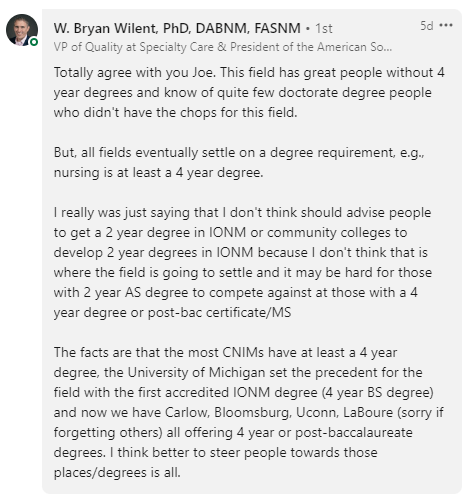What Is Your CNIM Worth?
Imagine this: You go to school for 4+ years — purposely putting yourself into debt — only to realize the job you want only overlaps this expensive education on the margin.
So far, you’re in pretty good company with most students coming out of college.
Luckily, you get a job in an interesting field of neuroscience: intraoperative neuromonitoring.
You start working on day #1 with the expectation placed on you to learn not only the skills to do the job but to pass an exam to certify your competency to do so. That narrows down the company you now keep with other specialists, like MBAs, CFAs, etc.
And it makes sense, seeing as you’re going to be putting 200mA of electricity into someone’s head as a “good place to start.” The MBA in your company might be in charge of millions in revenue and the future employment of entire teams, so you feel a little better if they have some idea what they’re doing too.
Accordingly, you put in the work (your first 6 months will be your busiest). As you travel that tedious path, sure to get some bumps and bruises along the way, you come to find out this harsh truth: the CNIM is a luxury item.
Hello, Reality.
If you’re just now hearing this and feel like you just got a kick in the stomach, hang in there.
Understanding the CNIM is a luxury item is important for all of us, but not for the most obvious reasons.
There’s another force at play here. Chances are you had no idea it was happening right under your nose (it wouldn’t matter if it did). You’re human and susceptible to conform to default’s gentle nudge.
We’ll explore those reasons, but first, let’s talk about something a little more fun to help make this a softer landing: scotch.
The CNIM and Scotch
While I don’t condone mixing scotch and neuromonitoring, I do find it useful to compare the two, as they both fall into this category of luxury items.
I personally don’t know much about scotch. In a blind taste test, I couldn’t tell you the difference between a $5 shot and a $50 shot. Although, you’d think I should since one has 10X the value, right?
Maybe it’s just me. Like scotch, I’m equally as oblivious to wine, handbags, and Bored Apes. But I do know this: there’s more to this category than barley, grapes, cowhide, and pixels. There are billions spent on these things with no chance of becoming a commodity. There are seemingly infinite potential narratives for each luxury item. The results are nothing short of magic.
Whenever Magic Is The Answer, Assume You’re Wrong
That’s a pretty good heuristic to use. But not always. The reason we can’t control spending copious amounts of money on our scotch defies our understanding of ourselves as totally rational actors. As the expert economist on CNN says, we make good choices to optimize our lives.
Always.
Except when we look at our bar tab. That’s the moment of clarity when we realize our emotional/irrational system took over.
When we buy a round of $50 shots for you and the crew, it’s easy to do some quick math to see how much time and energy we value on 4.5 ounces of liquid. If we earn $25/hr with a 50% tax rate, that means we think working a 12-hour day in exchange for two seconds on your lips is a fair trade. A rational actor would compare the price of that round to the $15 one and come to a different conclusion.
But what’s driving me to post up at the bar to overpay for some malted juice sitting in a barrel for 10 years? It’s because I’m building on the moment where I pull the big bills out of my leather Louie V man-bag to over tip the waitress (crap, add another 4 hours of work) in front of my friends.
It’s not the drink I paid for. It’s the signal. I’ve been sold a story on how to act: present oneself in the midst of luxury.
We’re signaling to ourselves and the world that we’re 1) fit enough to engage in a game of high-stakes chance (i.e. we won’t go broke) or 2) already positioned well enough that we don’t have those concerns. Either way, it’s not the smoky taste or the feeling of intoxication that drives us to partake in this performance of peacocking, it’s our human condition leaving us susceptible to our memetic desires. We live a life where we look to fit in with exhilarating moments of standing out.
You can’t blame me, it’s a beautiful one resulting in confirming my story as a refined southern gentleman with the right amount of flare. A prescriptive guide on how to achieve this level of peak performance mixed with the right amount of mystery better understood by the elite few.
If you don’t understand = your loss. I mean look at just about any ad. It’s spelled out if you care to look. It’s how we (the lucky ones) do things around here.

Transparency Leads To More Mystery
I’m more than happy to let you know how great it is. Attention is the oxygen of luxury. So the more I show you, the more details that surface, the easier it is for you to take the red pill and truly understand (if you’re worthy). If you’re thinking logically, there’s quite a chiasm to cross. If you’re thinking emotionally, intrigue creates momentum and carries you towards the mystery. You all but have to trip to reach the other side.
But that brings with it some problems. Not everyone can have the option of the red pill vs the blue pill. There wouldn’t be a need for a pill at all if they could. You can’t achieve a level of the highest enlightenment if everyone is on the same page.
No, no. This is a tricky balancing act of creating a heightened desire + maintaining an appropriate amount of exclusion. There has to be enough revealed that people are aware of its importance, even if they don’t understand it fully. Some will never taste our scotch as a matter of principle.
Now, some willingly do so and take our word that this shot is soooooo worth the $50. But others (these poor others) want nothing more than a taste. These people are the necessary sacrificial lambs.
That’s right… we must sacrifice lambs in order to maintain this level of luxury. Being “fair” usually revolves around the pack, not the individual. Some must be left out in order for the rest to live at a higher level.
And this is where we return to the CNIM as a luxury item.
Are You the Wolf or the Lamb?
The CNIM, with its historically low pass/fail rates, established itself early as the luxury item of the field. But not right away.
Here’s how it played out:
In 1996, a few smarty pants earned this credential that hadn’t previously existed. And then a few more. As it grew in number, it grew in recognition. Those that had it held it in esteem. They spoke highly of it since not everyone could pass it. Guess what… what gets mentioned matters.
The wolf pack was forming.
Fast forward to today and it’s almost a prerequisite to passing a hospital’s credentialing department.
Somewhere along the line, the CNIM transitioned from a “what’s that?” to a “nice to have” to a “luxury.” It did so as the transparency led to more mystery. All of a sudden, it made a whole lot of sense to drink a $50 shot of scotch. And it was the hospitals pushing us to build a “top shelf” where the best are separated from the rest.
The Golden Rule: Those That Hold the Gold Make the Rules
Hospitals, not really understanding what it is we do, had to start asking themselves “who is this we have in our room, and are they doing that thing well?”
It was a matter of trust (rightfully so) and the burden of proof was on us. And since they control who gets the money, they control who is doing what. Our response had to be one in line with establishing legitimacy.
The solution was for an accredited organization (ABRET) to verify a select group of people met some set of standards, as recognized by the certification. Large organizations of ours (ASET, for example) began to form, better coordinating the wolfs into a bigger pack. The wolfs backed those standards and backed the CNIM because the rules of a pack are always to make a decision of “we over me.”
Those not able to obtain the CNIM, even if they can do the work, have become sacrificial lambs. Those that have the CNIM and promote it as a crucial step in the legitimacy of neuromonitoring are part of the wolf pack. The ones who belong to the pack, where all the luxury resides, are higher up on the pecking order; they set the norms.
As you can see, calling the CNIM a luxury item is not calling it a “nice-to-have” (that’s the misinterpretation I’ll have to clear up for those just skimming headlines). It’s more of a description of how we go about treating it, defending it, and promoting it. The reality is while it hasn’t hit the 100% consensus as a requirement, it’s close enough for you to act as if.
Is Luxury The Final Stop, Or Part of the Evolution?
Pretty much all credentialing is a luxury item, from certifications to doctorates. They all entice and restrict. There’s a cost associated with each. But what’s just as important is to understand the strength (current) and staying power (future) of each luxury item.
Right now, the CNIM has moved out of “nice to have” to something more necessary. If you want to be valuable to your company and the facilities you practice in, you need to get it.
That’s the now. But what about tomorrow? What are the pressing problems now and into the future, and what utility does the CNIM serve?
If things are as they should be, then keep the status quo. Right now, the CNIM fits the role of solving the hospital’s ever-increasing credentialing requirements. If you don’t have it and want to keep practicing, my advice is to test for the CNIM and get it.
If the CNIM loses it’s luxury status and they stop requiring it, feel free to skip out on taking it.
What if this moment of staffing issues continues? To meet that need, maybe we lift some of the restrictions. We sacrifice some luxury for utility and let more people sit for the exam. My advice here: go get the CNIM so you don’t get left out.
What if we double down on credibility? It’s been a thorn in our side for years. Do we make it more restrictive and luxurious? Do we sacrifice even more lambs by making a college degree in IONM a requirement? My advice: upgrade your luxury status and get what wins out, the CNIM or IONM degree, and don’t share the fate of the sacrificial lamb.
Who’s Talking About Luxury Items Anyways?
Really, it’s probably not the hottest topic right now. It was a little more fun to speculate its future when some major institutions came out with degrees in the field. But that hasn’t caught fire. Generally speaking, the trend has been a slow progress of health systems, hospitals, and surgery centers all requiring the CNIM, no matter what other credentials or degrees you might have.
But this conversation of luxury is happening behind closed doors and out in the open.
J Jones wrote a nice LinkedIn post on his takeaways from and ASET conference, calling for us to band together to solve the staffing issues. Below is some additional discussion in the comments of that post, trying to work through what’s fair/important now vs the future in terms of luxury.
It has it all. Credibility and signaling. Transparency and mystery. Inclusion and exclusion. Wolfs and lambs. It’s a pretty good glimpse into how those heading up associations and companies are thinking.
Conclusion: The CNIM is IONMs Luxury Item
For those starting their IONM career, or still needing to pass the CNIM, I hope seeing the CNIM in this context gives you a different perspective on what to expect if you do or do not have the CNIM going forwards. My best guess is that it is going to be the industry standard for quite some time… until it isn’t. At that point in time, it will be grandfathered into whatever the newest luxury item takes over (too much lambs’ blood would be shed otherwise).
So come join us on this side of luxury. The scotch might not live up to the hype and burn just the same, but it’s always better (and safer) when you’re drinking amongst friends.






Epic read!
Awesome article Joe! Right in point as always. Thanks for putting this true perspective out there for the old and new school to see and evaluate on their own!
Full time Surgical Neurophysiologist ~ Part time Philosopher
…or is it ViceVersa?
Eccentric prose, but nicely developed. I’m amused by how you weave your professional experience + wisdom, and it’s resulting reflections into a properly concluding story.